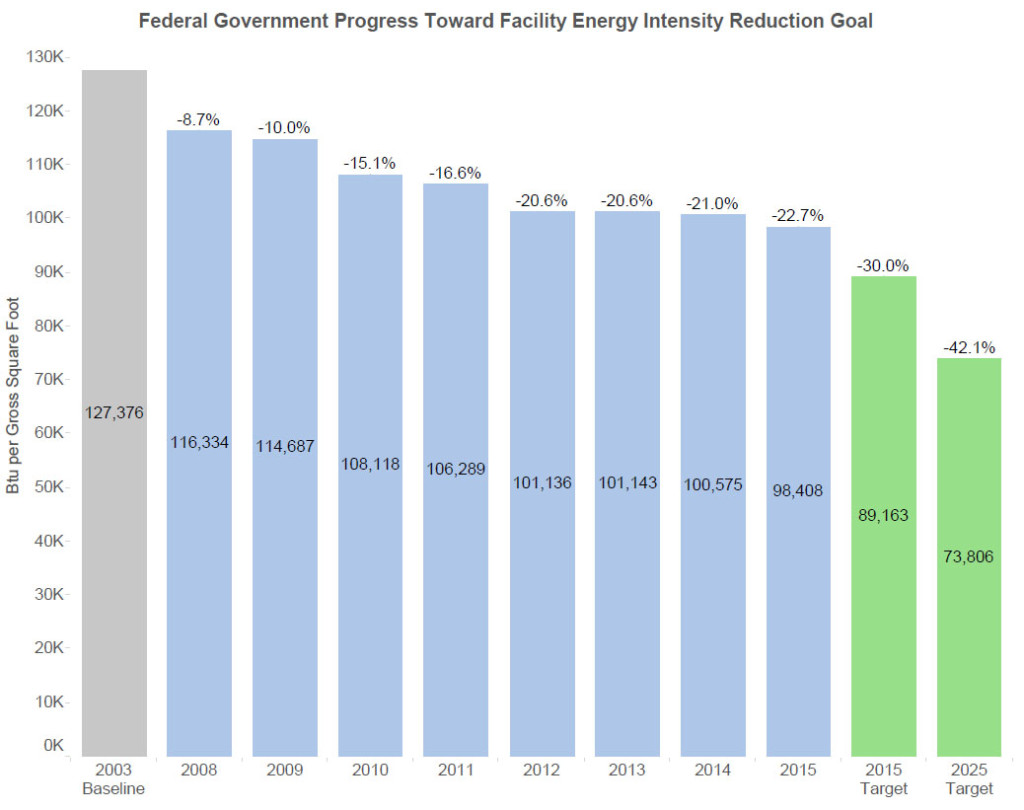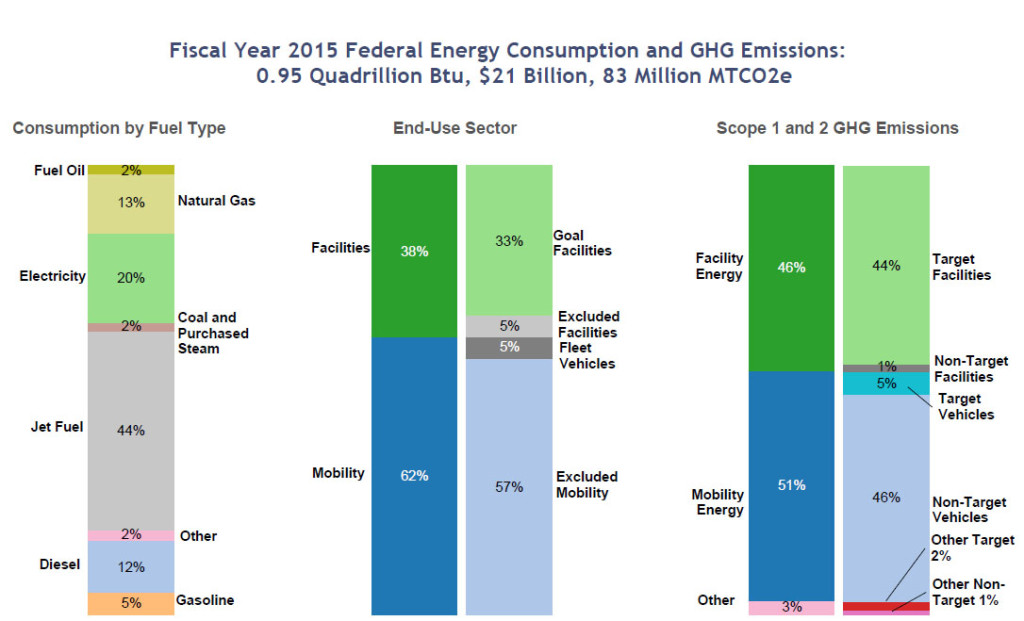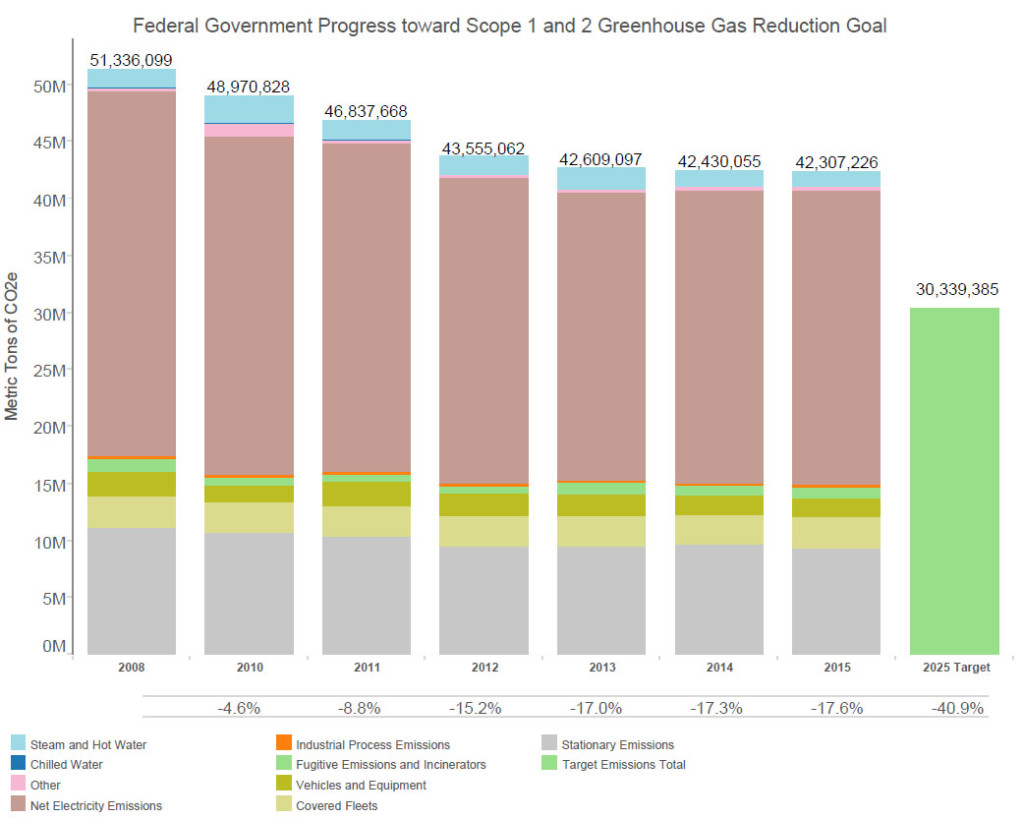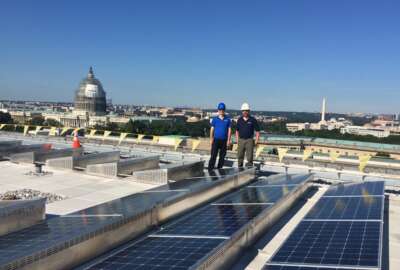
Government getting greener, but cold weather leaves its mark on energy use
New numbers from the Energy Department show the government is meeting or exceeding greenhouse gas goals, but energy intensity benchmarks fell short.
The federal government is improving its greenhouse gas emissions and energy consumption, according to the Energy Department, but a years-long streak of cold winters prevented agencies from hitting all of their fuel goals.
New fiscal 2015 numbers on federal energy consumption and emissions show the government fell short on its building energy intensity reduction — a 22.7 percent reduction from the fiscal 2003 baseline versus the 30 percent goal, and a reduction of 2.2 percent for Btu per gross square foot, from fiscal 2014.
Burning a single match releases about 1 Btu, or British thermal unit, of energy.
“That performance needs to ramp up in the future since … in 2025 agencies should be looking at reductions of 2.5 percent per year on that goal,” said Chris Tremper, program analyst for the Energy Department’s Federal Energy Management Program (FEMP), during an Aug. 4 webinar.
The reduction goal since 2012 has been relatively flat, Tremper pointed out. In 2012 and 2013 the percent reduction goal was 20.6 percent, while in 2014 it was 21 percent.
Tremper said this flat performance is due in large part to the weather.
“We took a look at what the national heating degree days were for the past couple years, and since 2012, they’ve been way up there, in fact they’ve increased by about 24 percent,” Tremper said. “When you consider half of the energy used in federal facilities is for heating, of course that’s going to have an impact on the goal in 2015.”
Data on energy intensity reduction has been collected since 1975, Tremper said, and in terms of Btu per square foot, the government has decreased its intensity by 47.4 percent, which “does compare very favorably” to the commercial and residential sectors.
“The government is showing some leadership at least in this area,” Tremper said.
The Defense Department represents about 60 percent of energy intensity, followed by agencies like the Justice Department, Postal Service and Veterans Affairs.
“Just because an agency is energy intensive and it uses a lot of Btu per square foot doesn’t mean it’s necessarily bad,” Tremper said. The Environmental Protection Agency and the Health and Human Services Department “both use a very high energy intensity, but that’s the nature of their mission.”
10:40
Tremper said agencies like VA, which is predominantly hospitals, or Energy and its research labs, can score high on energy intensity. The same goes for Justice, which is comprised mainly of prisons, which are 24-7 facilities.
Making an impact on climate change
In fiscal 2015 the government used 0.95 quadrillion Btus of fuel, 83 million metric tons of carbon dioxide, at a cost of $21 billion.
“This amount of energy use is about 1.5 percent of the energy used in the U.S. overall,” Tremper said.
About 44 percent of fuel consumption is made up of jet fuel, followed by 20 percent electricity, 13 percent natural gas and 12 percent diesel. Coal, steam, gasoline and other fuels made up the rest of the consumption totals.
According to Energy numbers, about 97 percent of greenhouse gas emissions come from energy use, which is broken down into 46 percent facility energy use and 51 percent mobility energy use.
About 57 percent of mobility is excluded, Tremper said, because that fuel is used for “purposes of the military, tactical, training use.”
Also excluded is energy used for law enforcement, emergency response vehicles and space flight, “all of these are based on mission and aren’t subject to any reduction goals,” Tremper said.
On Aug. 2 the White House released final guidance on agencies’ impact to climate change when conducting their National Environmental Policy Act reviews.
The hope with the guidance is “to help agencies make informed and transparent decisions about the impacts of climate change associated with their actions.”
Tremper said the government also made progress in renewable energy use. The goal for 2015 was set at 7.5 percent of electricity coming from a renewable source, but last year the government reached 8.3 percent.
The 16 percent reduction goal for potable water use intensity was also exceeded — 21.8 percent reduction compared to 2007 numbers.
Non-potable water use for industrial, landscaping and agricultural use was reduced by 27 percent compared to 2010 baseline numbers.
Copyright © 2025 Federal News Network. All rights reserved. This website is not intended for users located within the European Economic Area.
Related Stories





